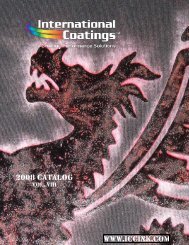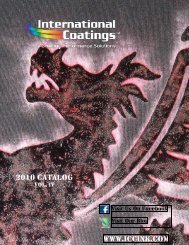2008 CATALOG WWW.ICCINK.COM
2008 CATALOG WWW.ICCINK.COM
2008 CATALOG WWW.ICCINK.COM
You also want an ePaper? Increase the reach of your titles
YUMPU automatically turns print PDFs into web optimized ePapers that Google loves.
Pre-Heating<br />
Because nylon fabric changes size when heated (as in flashing), pre-heating the fabric or jacket<br />
before printing is highly recommended. Pre-heating also helps to remove wrinkles from the<br />
fabric. Wrinkles or creases can often show up in the printed images, causing misprints. The<br />
fabric or jacket should be sent through the dryer or pre-heated with the flash cure unit for<br />
approximately 2 to 5 seconds, reaching a temperature of 150°F to 200°F. The flash cure unit<br />
should be set between medium and medium high heat. Flash cure units with one heat setting will<br />
need to be adjusted and tested for correct height and dwell time. Flash cure units that swing in<br />
and away automatically, at a set time, are highly recommended.<br />
All flash cure units should be adjusted for dwell time and temperature before production begins.<br />
Single Color Printing<br />
The Nylon fabric must be held securely in place, even on a single color print. Correct amount of<br />
off contact and clean screen break immediately after the squeegee passes is extremely important<br />
in eliminating slurring or double imaging.<br />
Multi-Color Printing<br />
Both spot color and process multi-color printing success is dependent on ink film thickness.<br />
Flashing time will vary according to the ink film thickness. Nylon fabric should be printed while<br />
warm. If the fabric is printed while hot the ink may start to gel in the screen. Nylon that is left to<br />
cool for too long, generally changes size or shape slightly. The change will cause missregistration<br />
in the print.<br />
Curing<br />
The heat element distance should be high enough so the fabric does not scorch. The entire ink<br />
film (both area and thickness) must reach 300°F to 325°F (149°C to 163°C) to achieve a full cure.<br />
The ink film adhesion will become stronger and more abrasion resistant over the next 48 to 72<br />
hours.<br />
Frequently Asked Questions<br />
Q. -- Why do I have to use a two part ink system?<br />
A. -- Most of the 1-part nylon inks on the market today are solvent based. These inks usually<br />
have a strong odor, are very slow flashing and sometimes require 30 seconds or more to<br />
flash between colors. Strong solvents are normally required for the clean up of these inks.<br />
Unlike some one-part nylon inks, the 900 series inks are fast flashing and are great for<br />
multicolor printing. The 900 Series inks are low odor and will clean up with most low V.O.C.<br />
plastisol screen washes.<br />
Q. – Why is 900 Series better than a regular plastisol mixed with nylon adhesion promoter?<br />
A. -- The 900 Series inks and 900LF Catalyst were formulated to work together to give the best<br />
possible adhesion and durability on most nylon substrates. While the 900LF Catalyst will<br />
improve the adhesion of standard plastisol inks to problem fabrics, conventional plastisols<br />
generally will produce a less durable ink film when used on nylon.<br />
Q. – What is the recommended reducer or thinner?<br />
A. -- International Coatings recommends mineral spirits or 1110LF reducer.<br />
5<br />
118




